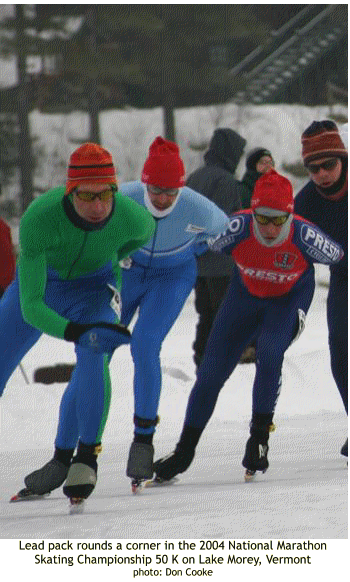 |  |  | ||||||||||||||||||||||||||||||||||||||||||||||||||||||||||||||||||||||||||
| ||||||||||||||||||||||||||||||||||||||||||||||||||||||||||||||||||||||||||||
The Planet Interview with Jamie Hess: The Nordic Skater Would Like You to Give Ice Marathons a Try (Part 2 of 3) Robert: How did your experience in Sweden change you? Jamie: When I got back, I quit my job as a software developer and started Robert: Where do you hold your marathon? Jamie: On a two mile long lake called Lake Morey. We don't use the whole lake for the race. We make a smaller loop so we can concentrate on good ice quality. But we also have a recreational trail that goes the whole length of the lake ... and it's the longest ice skating trail in the U.S. [2 miles] Robert: How many races are there at your event? Jamie: We have six: three on Saturday, three on Sunday. Robert: What are the distances? Jamie: They are all different. The shortest is a 1000 meter sprint; the longest is a 50 K; and there's everything in between. Robert: How long does it take the top racers to finish the 50 K? Jamie: It's about like a road cycling race. Typically, the winning time is about an hour and a half. If this were Europe, where the packs are larger and the skaters are faster, it would be something like an hour and 10 or 20 minutes. Robert: What is the ice like on the lakes? Jamie: It varies. At our event, we plow the snow off of the ice. Then we sweep it. And then we pump water from under the ice and flood the surface to smooth it out. It ends up almost as smooth as a rink. At some of the other events, all they do is plow and sweep -- they don't flood -- and you can be on some pretty rough ice. Robert: How many people generally attend these marathons? Jamie: The biggest events last year were both in Canada, and they had 100 to 150 skaters. Ours was the biggest in the U.S. We had several hundred people at the event, but only about 100 competing. Robert: What else happens during the events? Jamie: At ours, people come for the whole weekend. We rent a big lodge with six cabins and a dining room that seats 140 people. We all stay together, eat together under one roof, and skate together. We race in the morning and tour in the afternoon. Robert: I noticed that the Canadian coach Barry Publow races in some of the events? Do you get other high-level skaters? Jamie: The guy who won last winter's 50 K race was Peter Doucet from Toronto. Rob Kramer from Boston won the 25 K. Rob has probably won as many ice marathons as everyone else put together on this continent. But when he goes over to Europe to race, he's not in the back, but he's no where near the front. A couple more of the top skaters at our events are Mark Kandola from the Bay Area and Andy Dahlstrom from Seattle. (continued)
| Discuss: Talk About this Article ... Why don't more inline skaters give ice a chance? Links: | |||||||||||||||||||||||||||||||||||||||||||||||||||||||||||||||||||||||||||
... Copyright © 2006 by Robert Burnson | ||

